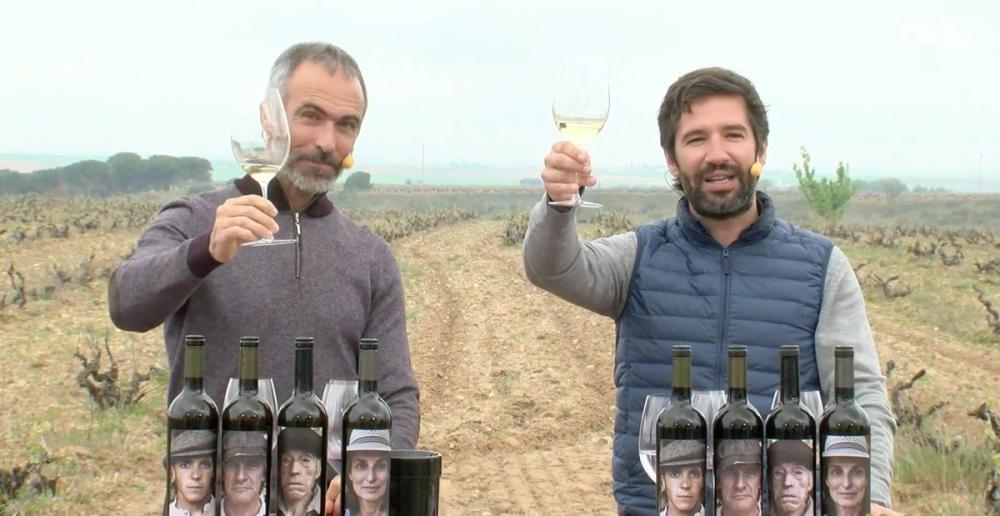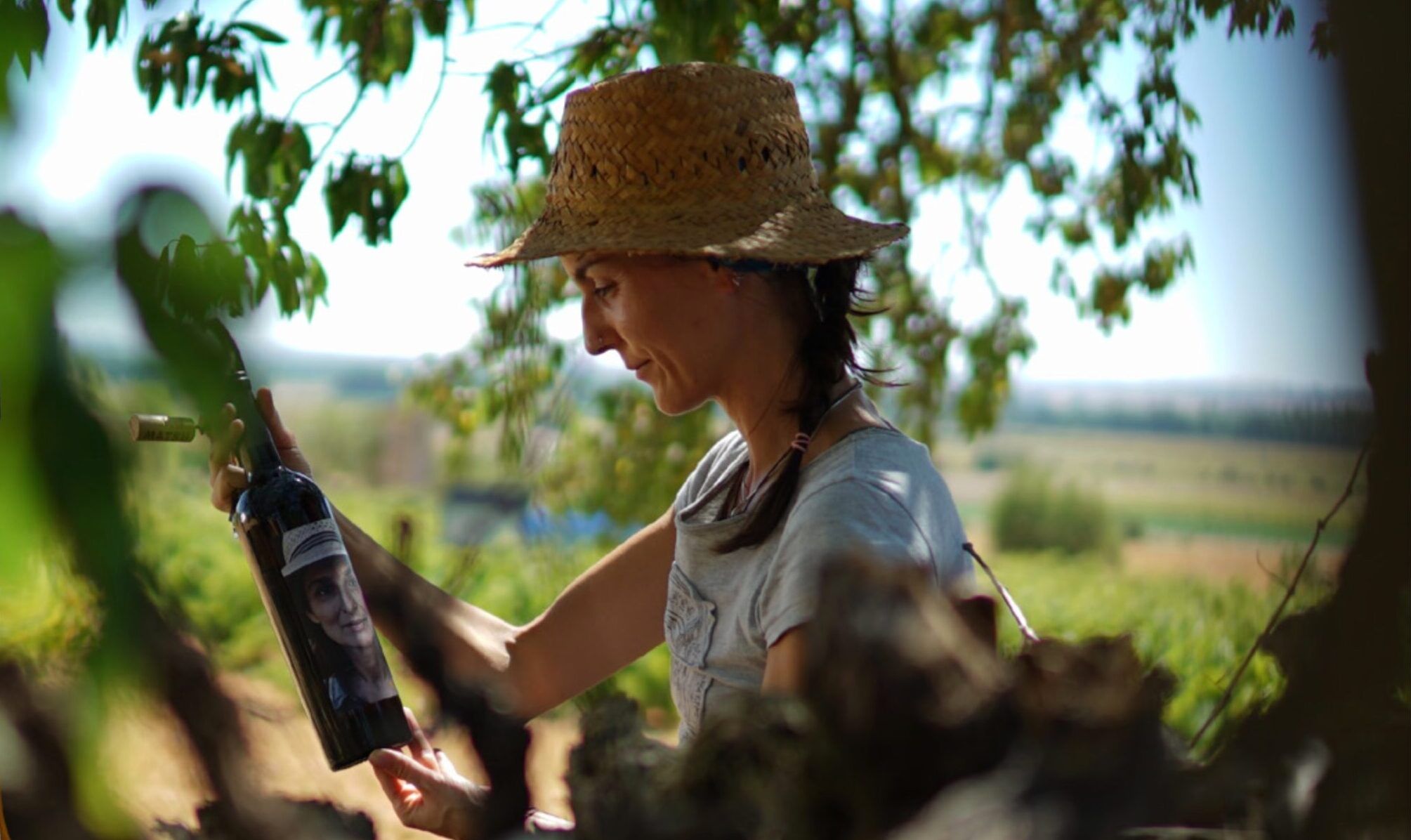“We want to show the world the real potential of these forgotten old white vineyards of Toro,” Arambarri says.

The vast plain of Castilla, Toro was the setting for one of the most imaginative wine launches to date – the gazebo housing one of the camera crews
Putting La Jefa into a little bit of context
The first time I met Richi Arambarri and Raul Ache was over a tapas supper in London five years ago. They were launching a series of six wines called the Garnachas Project, a superb range of wines that is helping set the record straight about this historically maligned grape variety and save many of Spain’s old vine Garnachas in the process – vines which were being grubbed up to make way for higher-yielding vines.
The Project shares many similarities with Bodega Matsu, the Toro-based winery which yesterday was launching its first white wine La Jefa, a wood-fermented Malvasia from 100+ year-old vines. In so doing it is also saving a bit of vinous history – old vines and also the reputation of Toro’s white wine production which has all but disappeared.
Matsu and Garnachas Project are two of seven wine ranges owned and operated by Vintae, the Rioja-based firm that has brought some much-needed FMCG sassiness and playfulness to the Spanish wine industry. All of the bodegas and projects it operates – Hacienda López de Haro Winery, Bardos, Bodega Matsu, Maetierra, Garnachas Project, Aroa and Atlantis – share a common vision and values.
For a start they detest wine snobbery and want to make wine accessible, understandable and part of discovering a region, its history, its people and culture. Their artisanal wines are authentic, with clear provenance, as naturally made as possible, with the sustainability box firmly ticked. And they are very smart cookies – just click on the Crew part of their website here scroll down and you’ll see what I mean.
And with all their projects they approach the wine consumer like a beer brand does beer drinkers – they are bold, direct, clear and also a lot of fun. (If you’re interested I wrote about Vintae’s FMCG approach to wine marketing here.)

Like a vinous version of Ant and Dec: Matsu/Vintae CEO Richi Arambarri and chief winemaker Raul Ache (r-l), April 21, 2020
The launch of La Jefa
“There’s not a lack of old vineyards in Toro but a lack of farmers who want to follow these old vineyards,” CEO Rich Arambarri explains, standing in a very old vineyard in Toro, at the live global launch of La Jefa 2018.
Together with Raul Ache , the chief winemaker of all of Vintae’s bodegas, Arambarri gives us a potted history of the region. They are standing on Castilla, the high central plain in Toro which is great for vines but not so nice for people. The climate has been famously described as ‘9 months of winter and 3 months of hell’ but the altitude is the saving grace in summer, giving cool nights as a respite from the searing heat.
This brings some much-needed freshness into the wines of Toro, not that you would have ever known that as historically the wines here are high in alcohol, tannin and colour. The typical wines from Toro are ‘naturally fortified’ and were kept like this so they would make the trans-Atlantic voyages some centuries ago. Arambarri explains (without mentioning Robert Parker) that it was some of the American critics in the past 20-30 years who helped keep them this way – they liked this intense, concentrated style of red wine and awarded them high scores, which inhibited changes in winemaking style, something Matsu is addressing with their more sympathetic and finessed approach.

Trying to make a point: the new La Jefa 2018, the first white wine from Matsu
White wines from Toro were also a thing of the past, slowly dying out with 95% of vineyards now dedicated largely to Tinta de Toro, one of the many regional synonyms for Tempranillo, the key difference in this region being the variety has smaller berry and bunch size and the bunches are more aerated. This fact, plus the climate and the deep, sandy soil means that the vast plain of Castilla is a haven for ‘natural’ winemakers as both vine disease and rot are rare. Which also explains the vast amount of very old vines, some as much as 150 years old, that managed to survive phyloxerra.
“We want to show the world the real potential of these forgotten old white vineyards of Toro,” Arambarri continues, drones capturing the event from every angle. “There is real potential for white wines here although the farmers who planted whites were either brave or crazy as they were never valued.”
In the past the white wines were table wines or blended to make clairettes, Matsu, however, wanted to prove a point so they have eschewed a simple winemaking style, opting instead for complexity and full body – ageing Malvasia in wood for 14 months, something they have experience of in the other 14 appellations they make wine in; at Hacienda López de Haro in Rioja, for example, they make a Gran Reserva Blanco that spends three years in French barrels, using Viura, Malvasia and Grenache.
So what does La Jefa and the other new vintages taste like?

And then there were four: Each label is a homage to the farmers of the past, and also reflect the escalating seriousness of the wines
La Jefa, 2018
Wood-fermented Malvasia from pre-phylloxera vines, blended with five other unspecified white varieties. The grapes are spontaneously fermented in new 600-litre French oak casks with light toasting. To look at the wine is deep straw gold; the aromatics are complex with ripe stone fruits, wild honey, pollen, seasoned wood, a touch of tropical fruit (banana) and vanilla pod. The palate is medium bodied, oleaginous and creamy, rich and ripe but with a decent structure, the acidity balancing well. The wine is called La Jefa (meaning “The Boss”) and is the fourth wine in an old vine series that uses very old vines in Toro, making wine in a fresher style than we’ve been accustomed to. It is built for ageing although it is drinking very well now. (£25 RRP)
El Picaro, 2020
100% Tinta de Toro (Tempranillo) made in a vin de soif style – going against the grain of how Toro wines were traditionally made, and making a juicy, fruity, lighter more ‘refined’ style. The fruit comes from very sandy soils with a high granitic content. The wine is spontaneously fermented in 15,000 litre concrete tanks, 10 days on skins, 15% whole bunch, malolactic fermentation and then 6-7 weeks lees contact. 2020 was a very generous year giving high yields – a perfect marriage of quality and quantity.
This all comes across in the wine which seems eager to please and be consumed copiously, nay, chugged. It is pale to medium purple, not unlike a young Beaujolais, which it partly resembles in colour, on the nose with its slightly confected black fruit/ jelly bean nose, blackberry jam, liquorice. The palate is fresh, structured but with rounded tannins, and is all about the sweet, fresh fruit. Ticks a lot of boxes, and you wouldn’t believe it is 14.5% abv. (£9.99 RRP)
El Recio, 2019
100% Tinta de Toro from 90 year old, low-yielding vines grown on sandy soils with a high granitic content. The fruit is 100% de-stemmed and fermented in 15,000 litre concrete tanks, macerated longer than El Picaro, for 12-14 days, the skins are then separated before the final part of fermentation, and ageing for 14 months in second use French and Eastern European oak barrels. 2019 was a more typical vintage for Toro with high temperatures and low rainfall, and consequently lower yields. To look at the wine is deep purple, opaque; on the nose it is a melange of black fruit, crushed strawberries, coconut, dark chocolate, wood; the palate is very full bodied, balanced and fruity, a lot of intensity, concentration and structure with substantial ripe tannins. How you might imagine a Toro wine to be – and needs more time. (£14.99 RRP)
El Viejo 2019
100% Tinta de Toro from pre-phylloxera vines of at least 100 years old, from sandy soils with a high granitic content. Cultivated naturally and sorted in the vineyard the fruit has static maceration for two weeks then aged in new French oak barrels for 16 months.
Like El Recio, this wine also has high concentration and intensity due to the hot, dry climatic conditions of 2019. Although it is much more of an easy-going wine – much smoother on the palate. To look at the wine is deep purple with black cherry edges, opaque; on the nose there is a mix of black fruit (wild bramble), cocoa, toasted nuts, charcoal, dark earth, spices; the palate is intense with ripe, grippy tannins on the front palate followed by a round, rich mouth-feel. Lots of concentration, structure and power but also a good deal of finesse on the edges. Needs a good few years of cellaring though. (£29.99)
The Bodega Matsu wines are imported into the UK for retail and on-trade by Majestic.








































